No.259 - "ニーベルングの指環" 入門(3)愛 [EX.80-114] [音楽]
|
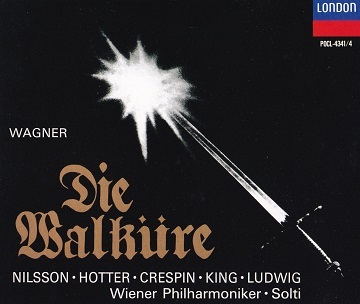
| ||
|
リヒャルト・ワーグナー
「ワルキューレ」
ゲオルグ・ショルティ指揮
ウィーン・フィルハーモニー管弦楽団 (新リマスター版CD 1997。録音 1965) | ||
CD1-Track15
Love is another of the central symbols of the drama, standing in direct opposition to the two central symbols of power, the Ring and the Spear. In the first place, it stands naturally in opposition to the Ring because the crucial condition attached to the making of the Ring is the Renunciation of Love. And this condition has its own motive, a tragic one in the minor key. It enters in Scene 1 of Rheingold. It's sung by the Rhinemaiden, Woglinde, when she tells Alberich that only the man who is prepared to renounce love can make the Ring from the Gold.
"愛" はドラマのもう一つの中心的なシンボルであり、それは "力" の中心的シンボルの2つ、"指環" と "槍" のちょうど正反対の位置にあります。そもそも "愛" が "指環" の対極にあるのは当然でしょう。なぜなら、指環を作る際の絶対の条件が《愛の断念》だからです。この条件は、それ自身を表す悲劇的な短調のモティーフを持っています。これは『ラインの黄金』の第1場で導入され、ラインの乙女のヴォークリンデによって歌われます。彼女がアルベリヒに、愛を断念する用意がある者だけが黄金から指環を作れる、と告げる場面です。
| EX.80: 《愛の断念》 |

This motive of the Renunciation of Love recurs at various points in the drama, most surprisingly perhaps, in Act 1 of Walkure. Siegmund sings it as he draws the Sword from the Tree, the decisive action which proclaims his identity as the brother of Sieglinde and her true lover.
《愛の断念》のモティーフはドラマの数々の時点で再現します。驚くことに『ワルキューレ』の第1幕でもジークムントが剣を樹から抜く時に歌います。彼はこの決断の行動で、ジークリンデの兄であると同時に真の恋人である自覚を宣言するのです(訳注:第1幕 第3場の最終場面)。
| EX.81: 《愛の断念》 ジークムント形 |
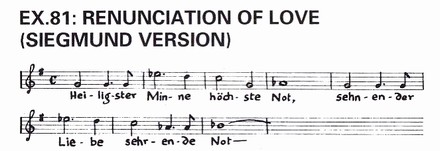
Siegmund's words refer to the need for which he has drawn the Sword, the deepest need of holiest love. From the total symbolic point to view, the whole drama, The Ring has begun in the world without love, and this is symbolized by the Renunciation motive. The claims of love only begin to assert themselves in Act 1 of Walkure, and they're only established in Act 3 in the Compassionate Love of Brunnhilde represented by the motive we heard a little earlier.
Wotan himself, in his own way, has renounced love as decisively as Alberich by offering Freia, the Goddess of Love, as a wage to the Giants for building Valhalla. And so the Renunciation motive is also associated with him, though in a different form. This stems from the second of the two phrases in the original motive. And the agent of transformation is Fricka in Scene 2 of Rheingold, when she tells Wotan that his bartering away of Freia shows his contempt for love. Here's the second phrase of the Renunciation motive as sung originally by Woglinde.
ジークムントは剣を抜く理由になった崇高な愛への深い欲求を語ります。象徴性の視点からドラマ全体を見ると『指環』は "愛なき世界" で始まり、《断念》のモティーフがそれを象徴します。愛への要求は『ワルキューレ』の第1幕でようやく主張され、第3幕の《ブリュンヒルデの哀れみの愛》で確立されます。そのモティーフは少し前に聴きました(訳注:EX.79)。
ヴォータンもアルベリヒと同様、彼なりのやり方で完全に愛を断念しました。つまり、ヴァルハラを建てた労賃として愛の女神であるフライアを巨人たちに差し出したからです。従って《断念》のモティーフは、少し違った形ですがヴォータンとも結びつきます。これは元々のモティーフの2つあるセグメントの2番目から生じます。そのモティーフの変形を担当するのが『ラインの黄金』第2場でのフリッカです。そのときフリッカは、ヴォータンがフライアを交換で手放したのは愛への侮辱だとヴォータンに言います。次が、ヴォークリンデが歌う元々の《断念》のモティーフの第2セグメントです。
ヴォータンもアルベリヒと同様、彼なりのやり方で完全に愛を断念しました。つまり、ヴァルハラを建てた労賃として愛の女神であるフライアを巨人たちに差し出したからです。従って《断念》のモティーフは、少し違った形ですがヴォータンとも結びつきます。これは元々のモティーフの2つあるセグメントの2番目から生じます。そのモティーフの変形を担当するのが『ラインの黄金』第2場でのフリッカです。そのときフリッカは、ヴォータンがフライアを交換で手放したのは愛への侮辱だとヴォータンに言います。次が、ヴォークリンデが歌う元々の《断念》のモティーフの第2セグメントです。
| EX.82: 《愛の断念》 第2セグメント |
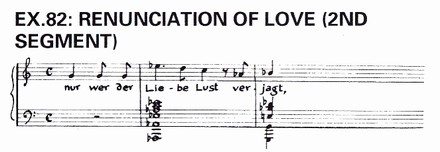
When Fricka accuses Wotan of despising love, the orchestra plays the first phrase of the Renunciation motive, but her utterance ends by hinting harmonically at this second one.
フリッカがヴォータンの愛への侮辱を責めるとき、オーケストラは《断念》のモティーフの第1セグメントを演奏します。しかし彼女の歌唱はこの第2セグメントの和声を暗示して終わります。
| EX.83: 《愛の断念》 第2形への移行 |
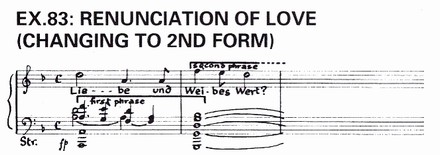
CD1-Track16
Later in the same Scene, Loge acts as a final agent of transformation when he says that, in all the world, he's been unable to find anything valuable enough to serve as a substitute wage for the Giants instead of the Goddess of Love, Freia. Here, he adapts the phrase of Fricka, which we've just heard, into the second form of the Renunciation motive which is to be associated with Wotan, and later with other characters.
同じ『ラインの黄金』第2場の後の方で、ローゲが《断念》の最後の変形を担当します。世界中を探したが、巨人たちへの報酬として愛の女神フライアの代わりなる価値あるものは見つけられなかったと彼が言う場面です。ここでローゲは先ほど聴いたフリッカのフレーズを《断念》のモティーフの第2形へと改変します。これはヴォータンに関連づけられ、後には他の登場人物とも結びつきます。
| EX.84: 《愛の断念》 第2形 |

This second form of the Renunciation motive often recurs as a mournful cadence expressing futility. One of the many examples is to be found in Act 2 of Walkure when Wotan, having realized his own lovelessness, describes himself as the unhappiest of men. Here's the whole passage, leading up to the use of the Renunciation motive as a cadence.
この《断念》のモティーフの第2形は、しばしば無益な行為を表現する "嘆きの終止形" として再現します。その多数の例の中の一つは、『ワルキューレ』の第2幕でヴォータンが愛の欠如を自覚し、最も不幸な男だと自身を表現するときに認められます。ここで《断念》のモティーフを終止形として使うに至る全体のパッセージを聴いてみましょう(第2幕 第2場。EX.76 の直後)。
| EX.85: 《愛の断念》 ヴォータンによる第2形 |
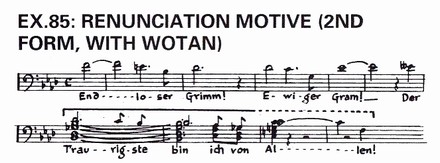
But the Renunciation motive in both its forms only represents love in a negative light, it stands for the general lovelessness prevailing in the power ridden world of the drama.
The basic love motive, positive, dynamic motive of love in action, in opposition to absolute power, is the one associated with the central symbol of love in the drama, the Goddess of Love herself, Freia. Her motive first enters on the orchestra in Scene 2 of Rheingold when she runs on persued by the Giants. Fricka describes her approach and Freia enters her motive introduced by the violins.
しかし《断念》のモティーフの2つの形とも "愛" の否定的側面だけを表しており、"力" が支配する世界に蔓延する愛の欠如を表現しています。
その絶対的な "力" に対抗し、肯定的で、実際の愛のように動的な基本モティーフがあります。それは、このドラマの中心的な愛のシンボル、愛の女神・フライア自身に関連づけられたモティーフです。フライアのモティーフは最初に『ラインの黄金』の第2場でオーケストラに現れます。そのとき彼女は巨人たちの追跡から逃れてきます。フリッカが彼女の接近を告げ、フライアが登場するときに、彼女のモティーフがヴァイオリンに導入されます。
その絶対的な "力" に対抗し、肯定的で、実際の愛のように動的な基本モティーフがあります。それは、このドラマの中心的な愛のシンボル、愛の女神・フライア自身に関連づけられたモティーフです。フライアのモティーフは最初に『ラインの黄金』の第2場でオーケストラに現れます。そのとき彼女は巨人たちの追跡から逃れてきます。フリッカが彼女の接近を告げ、フライアが登場するときに、彼女のモティーフがヴァイオリンに導入されます。
| EX.86: 《フライア》 |
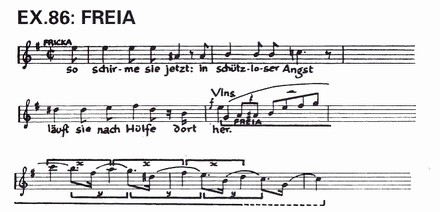
We can hear Freia's swift motive more clearly from another special illustration, the violin part played on its own, a little more slowly.
《フライア》のテンポの速いモティーフは、特別の例示でもっと明確に聴けます。ヴァイオリンのパートだけを少しゆっくりと演奏してみましょう。
| EX.87: 《フライア》 ヴァイオリン・パート |

CD1-Track17
Freia's motive has two independent segments and we may begin by considering the first, the rising one.
《フライア》のモティーフは独立した2つのセグメントを持っています。まず、最初の上昇するセグメントから考察してみましょう。
| EX.88: 《フライア》 第1セグメント |

This first segment of Freia's motive is swift here and in the minor to portray Freia's agitation as she flees from the Giants. But it soon establishes its definitive slow major form. This stands out clearly for the first time when it introduces Loge's 'Hymn to Love', a little further along in the same Scene.
この《フライア》のモティーフの第1セグメントは速いテンポの短調で、巨人たちから逃走するフライアの切迫感を描いています。しかしまもなく、ゆっくりとした長調の確定形になります。これは同じ場の少し後でローゲが "愛の賛歌" を歌うとき、初めてはっきりと目立つ形で現れます(訳注:第2場の EX.84 の直後)。
| EX.89: 《フライア》 第1セグメント - 確定形 |

This definitive sinuous form of the first segment of Freia's motive recurs on its own throughout The Ring in association with the sensuous aspect of love between man and woman. For example, in Act 1 of Walkure, after Siegmund's first fully impassioned utterance to Sieglinde, it ascends sweetly on the violins.
このしなやかな《フライア》の第1セグメントの確定形は『指環』全体で再現します。それは男女の愛の官能的な側面に関連づけられます。例えば『ワルキューレ』の第1幕でジークムントがジークリンデに最初の情熱的な言葉を口にするとき、このモティーフがヴァイオリンで甘美に上昇します(訳注:第1幕 第3場)。
| EX.90: 《フライア》 第1セグメント - ジークムントとジークリンデ |
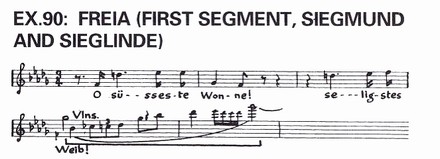
No new motives are generated from this first segment of Freia's motive. It remains itself throughout The Ring. The whole family of motives representing the various aspect of love is generated by the second segment of her motive which we'll recall now.
《フライア》のモティーフの第1セグメントから新しいモティーフは生成されません。これは『指環』全体を通してそのままの形で残ります。愛のさまざまな側面を表すモティーフのファミリー全体は、《フライア》のモティーフの第2セグメントから生成されます。第2セグメントを思い出してみましょう。
| EX.91: 《フライア》 第2セグメント |

This second segment of Freia's motive was identified wrongly by the very first commentator on The Ring, Hans von Wolzogen. He labeled it Flight. And every commentator since has followed him unthinkingly.
The whole motive enters in conjunction with Freia, and as with many other motives, its segments apply equally to the symbol it's attached to. It was not Wagner's practice to detach segments of his motives from the symbols that are initially associated with, and give them quite different meanings.
この《フライア》のモティーフの第2セグメントは、『指環』の最初の解説者であるハンス・フォン・ヴォルツォーゲンによって間違った認識がされました。彼は《逃亡》と名づけたのです。そして後世の全ての解説者は、考えなしにそれに従いました。
しかしモティーフ全体がフライアと結びついて登場しており、他のモティーフと同様、全てのセグメントが表現しているシンボルに等しく適用されるはずです。あるモティーフが最初にシンボルに関連づけられたあとで、モティーフのセグメントを切り離して全く違った意味を与えるというのは、ワーグナーの流儀ではありません。
しかしモティーフ全体がフライアと結びついて登場しており、他のモティーフと同様、全てのセグメントが表現しているシンボルに等しく適用されるはずです。あるモティーフが最初にシンボルに関連づけられたあとで、モティーフのセグメントを切り離して全く違った意味を与えるというのは、ワーグナーの流儀ではありません。
CD1-Track18
The label Flight might at times seem to be justified, since the segment does recur in something like its original form when various characters are in flight. For example, it portrays Siegmund and Sieglinde fleeing from Hunding in the Prelude to Act 2 of Walkure.
《逃亡》という名前は、時に正当化できるように思えるかも知れません。というのもこの第2セグメントは原形に近い形で、さまざまな登場人物が逃げているときに出てくるからです。例えば『ワルキューレ』の第2幕への前奏曲では、フンディングから逃げるジークムントとジークリンデを描写します。
| EX.92: 《逃亡》 |

However, the characters in flight here, Siegmund and Sieglinde, are symbols of love, as Freia herself is, even when fleeing from the Giants. And if we examine the second segment of Freia's motive, we find that it functions exactly like the first segment as a love motive. In conjunction with the first segment, it soon establishes a definitive slow major form. Here's the original Freia's motive, again, complete.
しかし、ここで逃亡している登場人物のジークムントとジークリンデは愛のシンボルです。それは、たとえ巨人たちから逃げているときでもフライアが愛のシンボルであるのと同じです。そして《フライア》のモティーフの第2セグメントを調べてみると、第1セグメントと全く同じように愛のモティーフとして機能していることがわかります。それはすぐに第1セグメントと結合した形で、ゆっくりとした長調の確定形になります。《フライア》のモティーフの原形を、もう一度完全な形で聴いてみましょう。
| 《フライア》 ヴァイオリン・パート: EX.87 |

CD1-Track19
When Fasolt, in Scene 2 of Rheingold, explains Wotan that he looks forward to having Freia as a wife in his home, the oboe accompanies his vocal line with the whole of Freia's motive, both first and second segments, in the definitive slow major form.
『ラインの黄金』の第2場においてファゾルトがヴォータンに、フライアを妻として家に迎えるのを楽しみにしていると説明するとき、彼の歌唱にオーボエが伴奏します。それは《フライア》のモティーフの第1、第2セグメントを含む全体の形で、ゆっくりとした長調の確定形です。
| EX.93: 《完全なフライア》 確定形 |
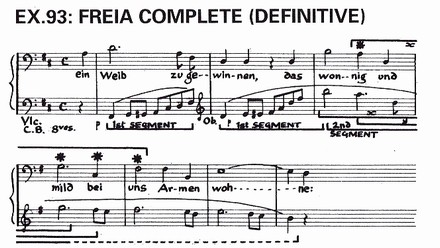
And the second segment of Freia's motive, in exactly the same way as the first, detaches itself in its definitive slow major form and recurs as a pure love motive in association with Siegmund and Sieglinde in Act 1 of Walkure. Here's the second segment again in its original swift minor form.
そして《フライア》のモティーフの第2セグメントは第1セグメントと全く同じように、ゆっくりとした長調の確定形で分離されます。その分離したセグメントは『ワルキューレ』の第1幕でジークムントとジークリンデに関連づけられた、純粋な愛のモティーフとして再現します。第2セグメントを、原形の速い短調の形で再度聴いてみましょう。
| 《フライア》 第2セグメント: EX.91 |

When Siegmund drinks the mead which Sieglinde has brought him and they stare into one another's eyes and fall in love, this second segment of Freia's motive enters in its definitive slow major form as their basic love motive.
ジークリンデが用意した蜂蜜酒をジークムントが飲むとき、2人は眼を見つめ合い、恋に落ちます。そのとき、この《フライア》のモティーフの第2セグメントがゆっくりとした長調の確定形で入ってきて、それは2人の愛の基本モティーフになります(訳注:第1幕 第1場)。
| EX.94: 《フライア》 第2セグメント - ジークムントとジークリンデ |
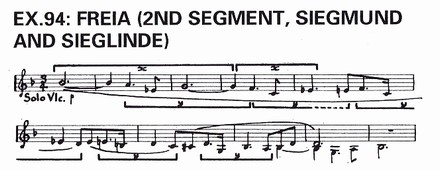
This basic love motive represents the compassionate aspect of love as opposed to its sensuous aspect which is expressed by the first segment of Freia's motive. It recurs in many different forms. Two main ones are slow and in the major, as here, and swift and in the minor, as at first, to represent love being driven out and pursued, hence the mistaken label of Flight.
There are certain passages where the swift minor form of the motive might seem to imply Flight, or at least pursuit, devoid of any associations with love. But these have been misunderstood. An example is the descent of Wotan and Loge to Nibelheim between Scenes 2 and 3 of Rheingold. Here, the second segment of Freia's motive is repeated over and over very swiftly in the minor. And a suggestion is that Wotan and Loge are in flight in some abstruse sense, or at least that they're in swift pursuit of Albrecht and the Ring.
この愛の基本モティーフは、《フライア》のモティーフの第1セグメントで表現される愛の官能的な側面とは対照的に、愛の哀れみの側面を表現しています。このモティーフは様々な形で再現します。その中心的なものは2つで、一つはここにみられるゆっくりとした長調です。もう一つは短調の速いテンポのもので、それはせき立てられ、追いかけられている愛を表現します。そのため《逃亡》という間違った名前がついたのです。
確かにこのモティーフの速い短調の形が、愛と関係がなく《逃亡》を含意するように見える、または少なくとも "追跡" と見えるパッセージもあります。しかしこれも誤解されてきました。その例は『ラインの黄金の』の第2場と第3場の間でヴォータンとローゲがニーベルハイムに下っていくシーンです。ここでは《フライア》のモティーフの第2セグメントが大変テンポの速い短調の形で何度も繰り返されます。ここでの意味は、ヴォータンとローゲが何らかの深い意味での逃亡状態にあることか、あるいは少なくとも2人がアルベリヒと指環を急いで追い求めているとも見えます。
確かにこのモティーフの速い短調の形が、愛と関係がなく《逃亡》を含意するように見える、または少なくとも "追跡" と見えるパッセージもあります。しかしこれも誤解されてきました。その例は『ラインの黄金の』の第2場と第3場の間でヴォータンとローゲがニーベルハイムに下っていくシーンです。ここでは《フライア》のモティーフの第2セグメントが大変テンポの速い短調の形で何度も繰り返されます。ここでの意味は、ヴォータンとローゲが何らかの深い意味での逃亡状態にあることか、あるいは少なくとも2人がアルベリヒと指環を急いで追い求めているとも見えます。
| EX.95: 《逃亡》ニーベルハイムへの下降 |
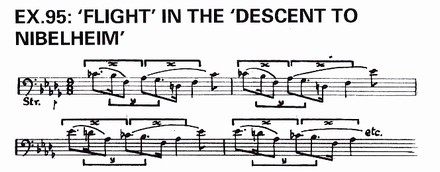
To understand the true significance of this passage, we have to realize that the origin of the second segment of Freia's motive, the basic love motive, goes back beyond Freia herself to Scene 1 of Rheingold. Here, a short embryonic form of it is introduced in association with the thwarting of Alberich passion by the Rhinemaidens. When Alberich is finally rejected by the third Rhinemaiden, Flosshilde, he introduces this embryonic form of the basic love motive rather slowly and in the minor to express his grief over the frustration of his wooing.
このパッセージの真の意味を理解するためには、愛の基本モティーフである《フライア》のモティーフの第2セグメントの起源が、『ラインの黄金』でのフライアの登場より前の第1場にあることを理解しなければなりません。つまりアルベリヒのラインの乙女に対する熱情が挫折することに関連して、愛のモティーフの短い萌芽形が出てくるのです。アルベリヒが最終的に第3のラインの乙女・フロスヒルデによって拒絶されたとき、彼は愛の基本モティーフの萌芽形を導入します。それは幾分ゆっくりとした短調で、求婚が挫折に終わった嘆きを表現しています。
| EX.96: 《フライア》 第2セグメント - アルベリヒ |

It's this short embryonic version of the basic love motive which is developed in the descent to Nibelheim. To make this absolutely clear, let's hear Alberich's lament in Scene 1 again, picking up the music a little earlier beginning with his cries of "Woe is me" which lead to his embryonic version of the basic love motive.
ニーベルハイムへの下降のシーンで展開されるのは、この愛の基本モティーフの短い萌芽形です。このことを完全に明確にするために、第1場でのアルベリヒの嘆きを再度聴いてみましょう。少し前のアルベリヒの "ああ情けない" という叫びのところの音楽から取り上げますが、それが愛の基本モティーフの萌芽形へと導きます。
| EX.97: 《アルベリヒの嘆き》 |

The descent to Nibelheim takes this passage as its starting point. It restates Alberich's cries of "Woe is me" more quickly and then it develops his short embryonic version of the love motive furiously, in the way made possible by the definitive continuous form of it, now associated with Freia.
ニーベルハイムへの下降は、このパッセージが出発点になっています。まずアルベリヒの "ああ情けない" という叫びが素早く繰り返され、短い愛のモティーフの萌芽形へと激しく展開します。それが、フライアに関連づけられる確定形へと変わっていくことを可能にします。
| EX.98: 《フライア》 第2セグメント - ニーベルハイムへの下降 |
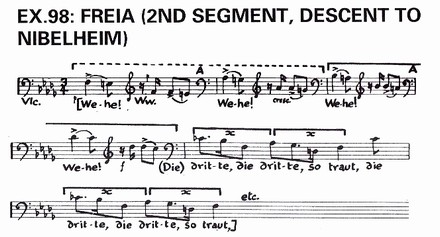
It's clear that when this passage begins, just after the music associated with Loge in Scene 2, Wagner employs a flashback technique which he often uses in orchestral interludes. He turns away from Wotan and Loge and their descent to Nibelheim, and picks up Alberich on his descent to Nibelheim from the Rhine after Scene 1. Alberich's thwarted desire a love has turned bitter, and is being transformed into a fierce lust of power,a familiar psychological phenomenon which is the true underlying meaning of the dependence of absolute power on the renunciation of love.
第2場のローゲが関係する音楽のすぐあとでこのパッセージが始まるとき、明らかにワーグナーはオーケストラ間奏曲でよく用いるフラッシュバックの技法を使っているです。ワーグナーは、ヴォータンとローゲと彼らのニーベルハイムへの下降はひとまず置いておき、第1場の最後でアルベリヒがライン河からニーベルハイムに下降するときの音楽を取り上げます。アルベリヒの愛への欲望の挫折は苦いものになり、それは力に対する激しい欲望へと変化しつつあります。愛を放棄するに当たって絶対的な力に頼るというのがその背景の意味であり、それはよくある心理現象だと言えるでしょう。
CD1-Track20
A little later in this interlude, the basic love motive enters in the new and more powerful form on the brass. It's still in the minor, but now it's slow and drawn out like the lament of love itself expelled from this world of naked power.
この間奏曲の中の少しあとで、新しい形の愛の基本モティーフがもっと力強く金管に入ってきます。それはまだ短調ですが、ゆっくりと引き伸ばされていて、むき出しの "力" の世界から追放されてしまった "愛" を嘆くようです。
| EX.99: 《フライア》 第2セグメント - ゆっくりとした短調 |

This powerful form of the basic love motive, slow and in the minor, attaches itself to Wotan in Act 2 of Walkure when he realizes his own lovelessness. He sings it at the beginning of the passage we heard earlier, the one illustrating the use of the second form of the Renunciation motive as a cadence expressing futility.
この力強く、ゆっくりとした短調の愛の基本モティーフは『ワルキューレ』の第2幕においてヴォータンに割り当てられます。彼が自分の愛の欠如を自覚するときです。彼は以前に聴いたパッセージの最初でそれを歌い、またこれは《愛の断念》のモティーフの第2形を、無益さを表す終止形として使う例になっています。
| EX.100 は第2幕 第2場で、EX.85 《愛の断念・第2形》と同じ箇所。 |
| EX.100: 《フライア》 第2セグメント - ゆっくりとした短調 |

This lamenting form of the basic love motive also attaches itself to Siegmund and Sieglinde in a more lyrical way. In Act 1 of Walkure when Siegmund momentarily feels that his love of Sieglinde is a forlorn hope, the definitive slow major form of the basic love motive which has been associated with their falling in love, now turns sadly to its minor form.
この愛の基本モティーフの "嘆きの形" は、もっと叙情的な形で『ワルキューレ』第1幕のジークムントとジークリンデに結びつきます。ジークリンデへの恋が絶望的なのではとジークムントが一瞬感じるとき、恋に落ちることに関連した愛の基本モティーフのゆっくりとした長調の確定形が、悲しげな短調の形に変わります(訳注:第1幕 第1場。EX.94 と同じ場面)。
| EX.101: 《フライア》 第2セグメント - ゆっくりとした短調 |

The definitive slow major form of the basic love motive later transformed itself freely to generate two new motives associated with the love of Siegfried and Brunnhilde in Act 3 of Siegfried. First, it forms the basis of the exultant theme known as the motive of Love's Greeting. They introduce this vocally when they hail the memory of Sieglinde as the mother of Siegfried.
ゆっくりとした長調の愛のモティーフの確定形は(訳注:EX.94)のちに自由な変形を遂げ、『ジークフリート』の第3幕においてジークフリートとブリュンヒルデの愛に結びつく新たな2つのモティーフを生み出します(訳注:第3幕 第3場)。まず《愛の挨拶》のモティーフとして知られる、喜びに溢れた旋律の基本を形づくります。2人がジークフリートの母のジーリンデの思い出を讃えるとき、歌唱でこのモティーフが導入されます。
| EX.102: 《愛の挨拶》 |
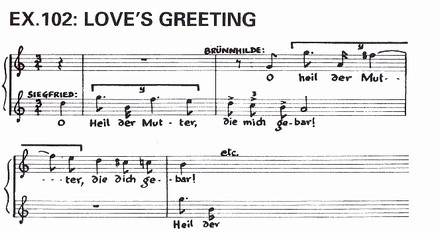
The relationship between this new motive of Love's Greeting and the basic love motive becomes entirely clear in a later passage when Brunhilde tells Siegfried that she was destined for him before he was born. This new motive enters on the woodwind, but Brunhilde immediately continues it in the shape of the basic love motive.
この新しいモティーフ《愛の挨拶》と愛の基本モティーフの関係は、後の歌唱で明らかになります。ブリュンヒルデがジークフリートに、彼が生まれる前から自分の運命づけられた人だったと告げるときです。この新しいモティーフが木管に入ってきますが、ブリュンヒルデはすぐに愛の基本モティーフの形で続きます。
| EX.103: 《愛の挨拶》 と 《フライア》の第2セグメント |
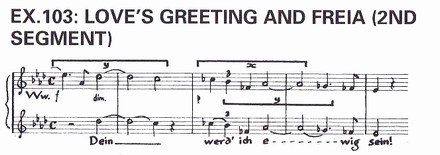
CD2-Track01
The other new motive generated by the basic love motive, is the bold one known as Love's Resolution. It strikes in nearly at the end of Siegfried to sum up the supremely confident character of the love of Siegfried and Brunnhilde. This motive is again a free transformation of the of the basic love motive. Its origin is the brilliant orchestral passage at the end of Act 1 of Walkure when Siegmund and Sieglinde fall into one another's arms. The basic love motive enters here in the major but quickly. That is developed to the swift telescoped form to express the joyful passion of the two lovers.
愛の基本モティーフから作り出される他の新しいモティーフは《愛の決心》として知られる堂々としたモティーフです。それは『ジークフリート』の終わり近くで登場し、ジークフリートとブリュンヒルデの愛が最大限に強いことを総括します。このモティーフもまた、愛の基本モティーフの自由な変形です。その原形は『ワルキューレ』の第1幕の終わりにおいて、ジークムントとジークリンデがお互いの両腕で抱き合うときにオーケストラに入ってくる輝かしいパッセージです。ここに出てくる愛の基本モティーフは長調ですが、テンポは速いものです。それは2人の恋人の喜びの情熱を表現するため、速く、縮められた形で展開されます。
| EX.104 は『ワルキューレ』第1幕 第3場で EX.81 のジークムントの歌唱のあと、幕が降りる直前のオーケストラ演奏。 |
| EX.104: 《フライア》 第2セグメント - 速い長調 |

It's this swift telescoped form of the basic love motive that broadens out majestically on the horns at the end of Siegfried to become the motive of Love's Resolution.
この、速くて縮められた形の愛の基本モティーフが『ジークフリート』の最終場面でホルンによって壮麗に展開され、《愛の決心》のモティーフとなります。
| EX.105: 《愛の決心》 |

This ends the family of motives generated by the basic love motive. But there are several other motives associated with the symbol of love which are quite independent.
First, there's the moving motive which represents the Bond of Sympathy between the Volsungs, Siegmund, Sieglinde and later it attaches itself to their son, Siegfried. It's first heard in Act 1 of Walkure. It enters in the bass with Sieglinde's motive above it when Siegmund and Sieglinde find themselves partners in distress.
これで愛の基本モティーフから作り出されたモティーフのファミリーは終わりですが、愛のシンボルに関連した、全く独立した数個のモティーフがあります。
まず《ヴェルズング族の共感の絆》を表す感動的なモティーフで、これはジークムントとジークリンデを表し、後には彼らの息子のジークフリートに結びつきます。このモティーフは最初に『ワルキューレ』の第1幕で聴かれます。ジークムントとジークリンデが互いに悩みをもつ仲間だと悟るとき、このモティーフが低音部に入ってきます。その上には《ジークリンデ》のモティーフを伴っています。
まず《ヴェルズング族の共感の絆》を表す感動的なモティーフで、これはジークムントとジークリンデを表し、後には彼らの息子のジークフリートに結びつきます。このモティーフは最初に『ワルキューレ』の第1幕で聴かれます。ジークムントとジークリンデが互いに悩みをもつ仲間だと悟るとき、このモティーフが低音部に入ってきます。その上には《ジークリンデ》のモティーフを伴っています。
| 《ジークリンデ》のモティーフについては EX.72 《ジークムントとジークリンデ》参照。《ジークリンデ》だけの解説はない。EX.106 は『ワルキューレ』第1幕 第1場の最終場面。 |
| EX.106: 《ヴェルズング族の共感の絆》 |
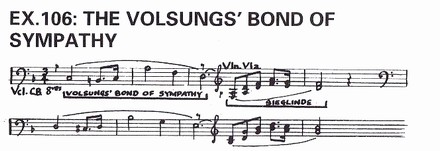
This motive is developed in several different ways throughout the whole drama. But when it later attaches itself to Siegfried, it takes on a quick excited form to express his agitation during his love scene with Brunnhilde.
このモティーフはドラマ全体を通していくつかの違った形で展開されます。しかし後にこれがジークフリートに結びつくとき、テンポを速め、興奮した形をとります。それはブリュンヒルデとの愛の場におけるジークフリートの高揚感を表しています(訳注:『ジークフリート』第3幕 第3場)。
| EX.107: 《ヴェルズング族の共感の絆》 第2形 |

Another independent love motives associated with Siegmund and Sieglinde is the melody of Siegmund song of spring, Wintersturme.
ジークムントとジークリンデに関連づけられた別の独立したモティーフがあります。それはジークムントが歌う春の歌、《冬の嵐》の旋律です(訳注:『ワルキューレ』第1幕 第3場)。
| EX.108: 《冬の嵐》 |

One of the independent love motive is associated with Wotan's Affection for Brunnhilde. He sings it near the end of Walkure just before he plunges Brunnhilde into her magic sleep.
独立した愛のモティーフの一つは、ヴォータンのブリュンヒルデへの愛情に関係しています。『ワルキューレ』の終幕近く、ブリュンヒルデを "魔の眠り" につかせる直前にヴォータンが歌います。
| このモティーフは《告別》ないしは《ヴォータンの告別》とも呼ばれる。 |
| EX.109: 《ヴォータンのブリュンヒルデへの愛情》 |
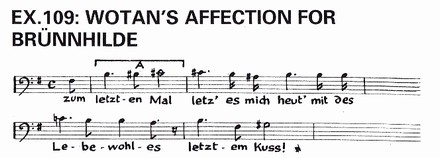
CD2-Track02
There are several independent love motives attached to Siegfried and the love between him and Brunnhilde. First, there's a yearning one associated with Siegfried's longing for human love and companionship. He is to replace Wotan in Brunnhilde's affections. And this motive begins with the same three rising chromatic notes as the one we've just heard associated with Wotan's affections for her. It enters in Act 1 of Siegfried, while Siegfried describes to Mime how he has watch the wooing and mating of the birds in the forest. It's worth noting that this motive goes straight over into the basic love motive.
さらに、ジークフリートおよび彼とブリュンヒルデの愛に結びつく数個の独立したモティーフがあります。第1に、人間愛と友情を切望するジークフリートに関連づけられる《憧れ》のモティーフです。ブリュンヒルデの愛情は、ヴォータンからジークフリート移ることになります。そしてこのモティーフは、さっき聴いた《ヴォータンのブリュンヒルデへの愛情》のモティーフと全く同じように、3つの上昇する半音階で始まります。このモティーフは『ジークフリート』の第1幕において、ジークフリートが森の小鳥たちの求愛と交尾を観察したことをミーメに語るときに入ってきます(訳注:第1幕 第1場)。このモティーフが愛の基本モティーフと直接的につながっていることに注目すべきでしょう。
| EX.110: 《ジークフリートの愛への憧れ》 |

There are four further independent love motives associated with Siegfried and Brunnhilde. The first is a jubilant leaping one which enters when Brunnhilde is fully awake and is generally known as the motive of Love's Ecstasy.
ジークフリートとブリュンヒルデに関連づけられる独立した愛のモティーフがさらに4つあります。その第1はブリュンヒルデが完全に目覚めたときに登場する、喜びに飛び跳ねるようなモティーフで、これは《愛の陶酔》のモティーフとして知られています。
| 以降の EX.111, EX.112, EX.113 は『ジークフリート』第3幕 第3場。 |
| EX.111: 《愛の陶酔》 |

Two of the other independent love motives attached to Siegfried and Brunnhilde are simply two of the themes that belong to the 'Siegfried Idyll'. The first, which is not a motive in the strict sense in that it never recurs, is the opening theme of that work which is introduced to represent Brunnhilde as the Immortal Beloved.
ジークフリートとブリュンヒルデに結びつく独立した愛のモティーフのうちの2つは、「ジークフリート牧歌」の2つの旋律と同じものです。一つは「ジークフリート牧歌」の冒頭の主題で、ブリュンヒルデを表現する《不滅の愛されし人》です。もっともこれは1回しか現れないので、厳密な意味でのモティーフだとは言えません。
| EX.112: 《不滅の愛されし人》 |

The other motive is the second theme of the 'Siegfried Idyll' which is sung by Brunnhilde to the words, 'Oh Siegfried, Treasure of the World', and has become known in consequence as the motive of the World's Treasure.
2つ目は「ジークフリート牧歌」の第2主題で、ブリュンヒルデが「おお、ジークフリート、世界の宝」と歌うときのものです。それにより《世界の宝》のモティーフとして知られています。
| EX.113: 《世界の宝》 |
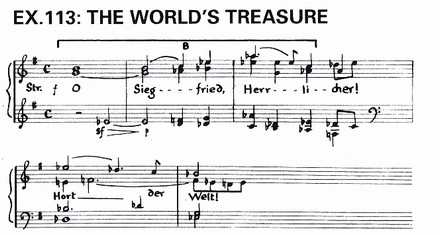
This motive does recur and derived from it is the final independent love motive, the one associated with Siegfried and Brunnhilde in Gottterdammerung, and known as the motive of Heroic Love.
このモティーフは再現し、そこから独立した愛のモティーフの最後のものが派生します。《英雄的な愛》として知られるモティーフで、『神々の黄昏』においてジークフリートとブリュンヒルデに関連づけられます。
| EX.114 は『神々の黄昏』の序幕のオーケストラ間奏のあとでブリュンヒルデが登場する場面。 |
| EX.114: 《英雄的な愛》 |

Here, we finish with the motives associated with the central symbol of love.
これで、"愛" という中心的シンボルに関連づけられたモティーフを終わります。
ライトモティーフ譜例一覧(3)
|
| 愛 |
| 《 | 愛の断念》 | |||
| 《 | 愛の断念》ジークムント形 | |||
| 《 | 愛の断念》第2セグメント | |||
| 《 | 愛の断念》第2形への移行 | |||
| 《 | 愛の断念》第2形 | |||
| 《 | 愛の断念》ヴォータンによる第2形 | |||
| 《 | フライア》 | |||
| 《 | フライア》ヴァイオリン・パート | |||
| 《 | フライア》第1セグメント | |||
| 《 | フライア》第1セグメント - 確定形 | |||
| 《 | フライア》第1セグメント - ジークムントとジークリンデ | |||
| 《 | フライア》第2セグメント | |||
| 《 | 逃亡》 | |||
| 《 | 完全なフライア》確定形 | |||
| 《 | フライア》第2セグメント - ジークムントとジークリンデ | |||
| 《 | 逃亡》ニーベルハイムへの下降 | |||
| 《 | フライア》第2セグメント - アルベリヒ | |||
| 《 | アルベリヒの嘆き》 | |||
| 《 | フライア》第2セグメント - ニーベルハイムへの下降 | |||
| 《 | フライア》第2セグメント - ゆっくりとした短調 | |||
| 《 | フライア》第2セグメント - ゆっくりとした短調 | |||
| 《 | フライア》第2セグメント - ゆっくりとした短調 | |||
| 《 | 愛の挨拶》 | |||
| 《 | 愛の挨拶》と《フライア》の第2セグメント | |||
| 《 | フライア》第2セグメント - 速い長調 | |||
| 《 | 愛の決心》 | |||
| 《 | ヴェルズング族の共感の絆》 | |||
| 《 | ヴェルズング族の共感の絆》第2形 | |||
| 《 | 冬の嵐》 | |||
| 《 | ヴォータンのブリュンヒルデへの愛情》 | |||
| 《 | ジークフリートの愛への憧れ》 | |||
| 《 | 愛の陶酔》 | |||
| 《 | 不滅の愛されし人》 | |||
| 《 | 世界の宝》 | |||
| 《 | 英雄的な愛》 |

|
2019-05-24 17:46
nice!(1)
No.258 - "ニーベルングの指環" 入門(2)指環・槍 [EX.39-79] [音楽]
|
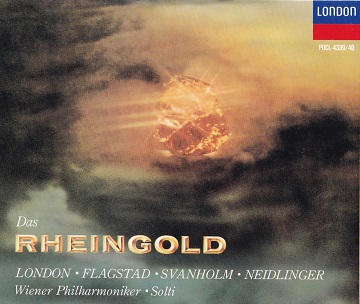
| ||
|
リヒャルト・ワーグナー
「ラインの黄金」
ゲオルグ・ショルティ指揮
ウィーン・フィルハーモニー管弦楽団 (新リマスター版CD:1997。録音:1958) | ||
CD1-Track07
The cause of the deterioration of the Gold from a life giving inspiration to an agent of misery and death is, of course, the Ring of absolute power which Alberich makes from the Gold and puts the such evil use. Alberich's Ring is a central symbol of the drama, one of the two central symbols of power.
And so it has its own basic motive which enters Scene 1 of Rheingold and later generates the whole family of motives. The first embryonic form of the Ring motive is the undulating vocal line of the Rhinemaiden Wellgunde in the major key when she tells Alberich that anyone who can make a Ring from the Gold will be able to dominate the world.
黄金が命を生む創造的存在から苦痛と死の使者へと堕落した原因は、もちろん絶対的な力を持つ "指環" にあります。それはアルベリヒが黄金から作って悪用したものでした。アルベリヒの指環はこのドラマの中心的シンボルであり、それは2つある "力" のシンボルの一つです。
従って指環はそれ自身の基本モティーフを持っています。それは『ラインの黄金』の第1場で導入され、後にモティーフのファミリー全体を作り出します。《指環》のモティーフの萌芽形は、ラインの乙女のヴェルグンデの波のようにうねる長調の歌です。その歌でヴェルグンデは「黄金から指環を作れるものは世界を支配できるだろう」とアルベリヒに告げます。
従って指環はそれ自身の基本モティーフを持っています。それは『ラインの黄金』の第1場で導入され、後にモティーフのファミリー全体を作り出します。《指環》のモティーフの萌芽形は、ラインの乙女のヴェルグンデの波のようにうねる長調の歌です。その歌でヴェルグンデは「黄金から指環を作れるものは世界を支配できるだろう」とアルベリヒに告げます。
| EX.39: 《指環》 萌芽形 |

When Alberich reflects on Wellgunde's words, the orchestra repeats her vocal line. And then he sings the tauter version of it in the minor key as he soliloquize on the possibility of absolute power.
アルベリヒがヴェルグンデの言葉を思案しているとき、オーケストラは彼女の歌を反復します。そしてアルベリヒが絶対的な力の可能性を独白するとき、彼はもっと緊張した形を短調で歌います。
| EX.40: 《指環》 中間形 |
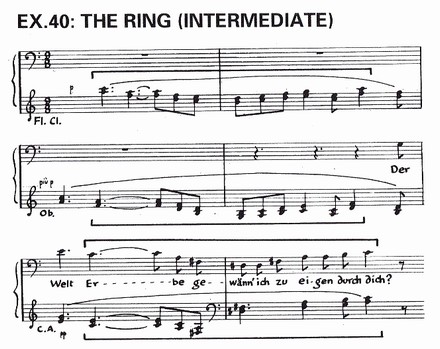
This is almost the definitive form of the sinister Ring motive. And it soon emerges clearly on clarinets and horns near the end of the orchestral interlude leading to the next Scene.
これは不吉な《指環》のモティーフの確定形とほとんど同じです。その確定形は、次の場へと続くオーケストラの間奏曲の最後の付近で、クラリネットとホルンに明確な形で現れます。
| EX.41: 《指環》 確定形 |

The Ring motive is a melodic form of a chord, just as the original Nature motive is. But whereas the notes of the Nature motive make up a major chord, those of a the Ring motive make up a complex chromatic dissonance in the minor key composed of superimposed thirds. We can hear this sinister harmonic basis of the Ring motive by means of a special illustration, the motive played by woodwind with all its notes sustained and kept sounding as a chord.
《指環》のモティーフは、《自然》のモティーフがそうであるように和音の旋律形です。しかし《自然》のモティーフが長調の和音であるのに対し、《指環》は短調の複雑な半音階的不協和音で、3度の音程が重ねられています。特別の例示で《指環》のモティーフの不吉な和声を聴くことができます。木管楽器でモティーフの全ての音を和音として響くように引き伸ばしてみましょう。
| EX.42: 《指環》 基本和声 |

This special illustration helps us to follow the evolution of two important motives belonging to the Ring's family. First, the motive of Scheming which is mainly associated with the efforts of the Niebelungs to get possession of the Ring. This is a kind of groping outline of the Ring's harmony. This can be heard from another special illustration. Here's the Ring motive played by the cellos' pizzicato with two bassoons holding the upper third and then fall into the lower third.
この特別の例示は、《指環》のファミリーに属する2つの重要なモティーフへの変形をたどる助けになります。第1は《思案》のモティーフで、これは主に指環を保持しようとするニーベルング族の労働に関連づけられます。このモティーフは《指環》の和声の骨格のようなものです。これを別の特別の例示で聴いてみましょう。次は《指環》のモティーフをチェロのピチカートで演奏したもので、伴奏する2本のファゴットは上の3度を保持したあと、下の3度に下がります。
| EX.43: 《指環》 骨格 |

The bassoons' outline of the Ring motive's harmony in that special illustration is the motive of Scheming as it appears definitively at the beginning of Siegfried in association with the plotting of Mime.
この例示のファゴットで示された《指環》の和声の骨格は《思案》のモティーフの確定形になります。それは『ジークフリート』の冒頭でミーメの企みに関連づけられます(訳注:第1幕 第1場)。
| EX.44: 《思案》 |
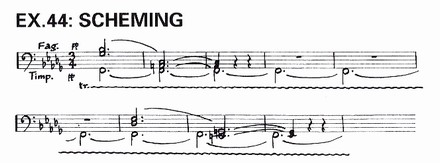
CD1-Track08
The other transformation of the Ring motive's sinister homony is the motive of Resentment which is introduced in Scene 4 of Rheingold to accompany Alberich's first bitter remarks when he is set free after having been robbed of the Ring by Wotan. One further special instruction will make this clear. Here's the Ring motive played by the clarinets with the central 3 notes of its harmonic basis left sounding the end of the chord.
《指環》の不吉な和声のもう一つの変形は『ラインの黄金』の第4場で導入される《怨念》のモティーフです。それはアルベリヒがヴォータンに指環を奪われたあと、解放された時に最初に言う毒舌の伴奏に出てきます。もう一つの特別の例示で、このことを明確にしましょう。次はクラリネットで演奏した《指環》のモティーフで、和声の中心の3つの音を和音として終わりまで響かせます。
| EX.45: 《指環》 減3和音 |

This diminished triad which lies at the heart of the Ring motive's sinister harmonic basis, is the starting point of the syncopated motive of Resentment.
《指環》のモティーフの根幹にあるこの不吉な響きの減3和音は、シンコペーションのモティーフである《怨念》の出発点になります。
| EX.46: 《怨念》 |

There's one further important effect of the harmonic basis of the Ring motives which should be mentioned, this is a case not of generating a new motive but of generating a new form of an already existing one. The already existing one is that of the Power of the Ring associated with Alberich in Rheingold and later. We hear it again as a reminder.
ここで《指環》のモティーフの和声の重要な効果について指摘すべき点があります。それは新しいモティーフが作られるのではなく、既存のモティーフの新しい形が作られるケースです。その既存のモティーフとは『ラインの黄金』やそれ以降のアルベリヒに関連づけられた《指環の力》です。リマインドのために《指環の力》をもう一度聴いてみましょう。
| 《指環の力》: EX.34 |
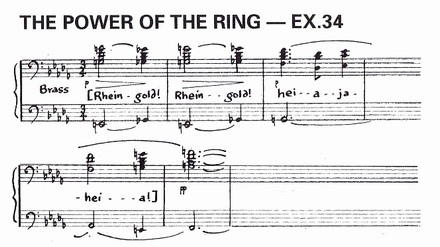
When this motive attaches itself to Hagen in Gotterdammerung, it takes on a slightly different harmonic form. It now begins with a pungent dissonance.
この《指環の力》のモティーフが『神々の黄昏』でハーゲンに割り当てられると、少し違った和声をとります。今度は鋭い不協和音で始まります。
| EX.47 は『神々の黄昏』第1幕 第2場の最終場面、ハーゲンの歌唱のところ。 |
| EX.47: 《指環の力》 ハーゲン形 |
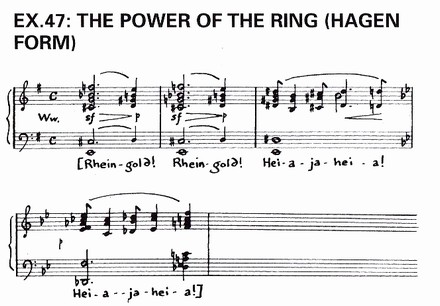
The dissonance which begins this form of the motive is quite simply the full harmonic basis of the Ring motive which our first special illustration will recall to us.
この形のモティーフの出だしの不協和音は、シンプルに《指環》のモティーフの和声の全部です。最初の例示で聴いたのを思い出してみましょう。
| 《指環》 基本和声: EX.42 |

As can be heared, this is the exact dissonance which begins the motive of the Power of the Ring in the form associated with Hagen.
聴き取れるように、これはハーゲンと関連づけられた《指環の力》の始めの不協和音と同じです。
| 《指環の力》 ハーゲン形: EX.47 |
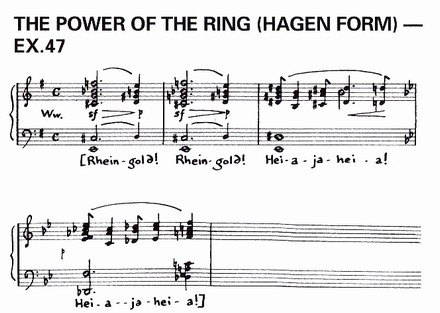
The dissonance which begins this form of the motive permeates Gotterdammerung and generates a new motive in Act 2. It acts as starting point of savage theme known as the motive of Murder which is heared in the orchestra when Alberich incites Hagen to kill Siegfried and get back the Ring.
このモティーフの出だしの不協和音は『神々の黄昏』の各所で出現し、第2幕で新しいモティーフを生み出します(訳注:第2幕 第1場)。それは《殺害》として知られている残忍な旋律の開始部分で、オーケストラに聴き取れます。アルベリヒがハーゲンに、ジークフリートを殺して指環を取り戻せと促す場面です。
| EX.48: 《殺害》 |
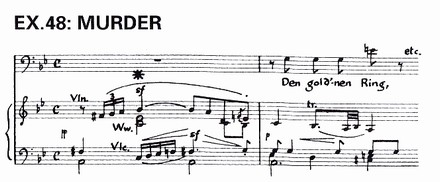
So this dissonance permeates Gotterdammerung, creating an atmosphere of progressive dissolution. Wagner made the sinister harmony of the Ring motive eat its way more and more into the fabric of the score to reflect the fact that the sinister symbol of the Ring itself eats its way more and more into the fabric of the drama.
そしてこの不協和音は『神々の黄昏』に染み渡っていき、次第に崩壊していく雰囲気を作り出します。ワーグナーは《指環》の不吉なハーモニーがスコアという織物に徐々に浸透するようにしています。それは不吉のシンボルである指環がドラマという織物に浸透することを反映しているのです。
CD1-Track09
Several other motives representing various aspects of the symbol of the Ring are generated by the melody of the Ring motive. Three of these stem from its first segment of four descending notes. The most important is the motive associated with the Curse which Alberich puts on the Ring in Scene 4 of Rheingold after having been robbed of it by Wotan. Here are the first four descending notes of the Ring motive.
シンボルとしての指環のさまざまな側面を表現するモティーフのいくつかは、《指環》のモティーフの旋律から作り出されます。このうちの3つは《指環》の最初のセグメントである下降する4つの音から生じます。最も重要なのは『ラインの黄金』の第4場で、指環をヴォータンに奪われたあとにアルベリヒが指環にかける "呪い" に関連したモティーフです。次が《指環》のモティーフの最初の4つの下降音です。
| EX.49: 《指環》 最初の4音符 |

These four notes are turned upside down to form the menacing motive of the Curse. This is introduced vocally by Alberich but its definitive form is established by the trombones a little later in Scene 4 of Rheingold, immediately after the first effect of the Curse, the murder of Fasolt by Fafner.
この4つの音は上昇下降を逆転させ、威嚇するような《呪い》のモティーフを形づくります。これはアルベリヒの歌唱で導入されますが、少し後の『ラインの黄金』の第4場でトロンボーンがこのモティーフの確定形を提示します。ファゾルトがファフナーに殺されるという、"呪い" の最初の発現の直後です。
| EX.50: 《呪い》 |

The other two motives generated from the first four notes of the Ring motive are those of Hunding's Rights in Walkure and the Vow of Atonement in Gotterdammerung. Hunding, if he is ignorant of the existence of the actual Ring, is nevertheless a wielder of the kind of ruthless power it symbolizes.
And as for the Vow of Atonement which forms part of the oath of blood brotherhood sworn by Siegfried and Gunther, the significance of the Ring shaped motive here is one of tragic irony. Through the vow, Siegfried puts himself entirely in the power of Hagen who uses it as a pretext for murdering him to get possession of the Ring.
Both these motives are direct transformations of the first four notes of the Ring motive which we'll hear again now.
《指環》のモティーフの最初の4つの音から生成される他の2つのモティーフは『ワルキューレ』の《フンディングの正義》と、『神々の黄昏』の《贖罪の誓い》です。フンディングは指環の存在については無関係だとしても、指環が象徴するある種の冷酷な力を持っています。
また《贖罪の誓い》はジークフリートとグンターの "兄弟の血の誓い" の構成要素です。ここで重要なのは《指環》から作られるモティーフが "皮肉な悲劇" を示すことです。つまり "誓い" によってジークフリートは、指環を手に入れるために彼を殺そうとしているハーゲンの術中にはまってしまいます。ハーゲンは "誓い" を口実にするのです。
この2つのモティーフとも《指環》の最初の4つの音の直接的な変形です。4つの音をもう一度聴いてみましょう。
また《贖罪の誓い》はジークフリートとグンターの "兄弟の血の誓い" の構成要素です。ここで重要なのは《指環》から作られるモティーフが "皮肉な悲劇" を示すことです。つまり "誓い" によってジークフリートは、指環を手に入れるために彼を殺そうとしているハーゲンの術中にはまってしまいます。ハーゲンは "誓い" を口実にするのです。
この2つのモティーフとも《指環》の最初の4つの音の直接的な変形です。4つの音をもう一度聴いてみましょう。
| 《指環》 最初の4音符: EX.49 |

Now here is the stern motive of the Hunding's Rights which is introduced vocally by Hunding himself to the words "Sacred is my hearth, sacred to you be my home".
さて次が厳粛な《フンディングの正義》のモティーフです。これはフンディング自身の歌唱で導入され、歌詞は「私の炉は神聖だ。私の家は君にとっても神聖だ」です(訳注:『ワルキューレ』第1幕 第2場)。
| EX.51: 《フンディングの正義》 |

And here's the tragic motive of the Vow of Atonement as introduced by Gunther and Siegfried in Act 1 of Gotterdammerung.
そして次が、悲劇的な《贖罪の誓い》のモティーフです。これは『神々の黄昏』の第1幕(訳注:第2場)でグンターとジークフリートによって導入されます。
| EX.52: 《贖罪の誓い》 |

CD1-Track10
Two further motives are evolved from the other segments of the Ring motive, its last three rising notes. Both enter in Scene 3 of Rheingold. The first is that of the Hoard of treasure which apears when Alberich tells Wotan about the Hoard and how he will use it to make himself master of the world.
The second is that of the Dragon which enters when Alberich transformed himself into a huge serpent ostensibly to demonstrate the powers of the Tarnhelm but really to warn Wotan and Loge of his power to guard the Ring in the Hoard.
Both motives are built out of repetitions of the rising third which ends the Ring motive, a note higher each time. And both are given into the tubas to suggest some monstrous evil rising from the depths to engulf the world. Here's the Ring motive again as a reminder.
他に2つのモティーフが《指環》の別のセグメントから派生します。それは《指環》の最後の上昇する3音から派生するもので、2つとも『ラインの黄金』の第3場に出てきます。第1は《財宝》のモティーフです。これはアルベリヒがヴォータンに財宝のことを話し、世界を支配するためにどう使うかを語るところで出てきます。
第2は《大蛇》のモティーフで、アルベリヒ自身が大きな蛇に変身するところで現れます。その変身は、表向きは "隠れ兜" の威力を誇示するためですが、本当は財宝の中の指環を守る力が自分にあることをヴォータンとローゲに警告しているのです。
2つのモティーフとも《指環》のモティーフの最後の上昇する3度を繰り返すことで作られていて、繰り返すたびに音は高くなります。また2つともチューバに割り当てられており、怪物級の "悪" が深淵から立ち上がって世界を巻き込むかのようです。リマインドのために《指環》のモティーフを再度聴きましょう。
第2は《大蛇》のモティーフで、アルベリヒ自身が大きな蛇に変身するところで現れます。その変身は、表向きは "隠れ兜" の威力を誇示するためですが、本当は財宝の中の指環を守る力が自分にあることをヴォータンとローゲに警告しているのです。
2つのモティーフとも《指環》のモティーフの最後の上昇する3度を繰り返すことで作られていて、繰り返すたびに音は高くなります。また2つともチューバに割り当てられており、怪物級の "悪" が深淵から立ち上がって世界を巻き込むかのようです。リマインドのために《指環》のモティーフを再度聴きましょう。
| 《指環》: EX.41 |

The last three notes of the Ring motive, repeated over and over by the tubas, generate the motive of the Hoard. Here it is as it occurs definitively in the Prelude to Siegfried with the Servitude motive repeated above it.
《指環》の最後の3音はチューバで何度も繰り返され、《財宝》のモティーフを生み出します。次は『ジークフリート』の前奏曲で確定的に現れる《財宝》です。その上で繰り返される《苦役》のモティーフと一緒です。
| Hoard of treasure という説明があるように、モティーフ名の hoard は "秘蔵物" の意味である。ここでは財宝と等価なので《財宝》とした。普通このモティーフは《財宝》と呼ばれている。 |
| EX.53: 《財宝》 |

The motive of the Dragon is a rather freer development of the last three notes of the Ring motive, but again it consists of repetitions by the tubas of a phrase revolving round a third, each repetition a note higher than the one before.
《大蛇》のモティーフは《指環》の最後の3音のいくぶん自由な展開です。しかしまたもチューバによる繰り返しで、3度の周りを巡回し、繰り返すごとに音程が高くなっていきます。
| EX.54: 《大蛇》 |

This Dragon motive later takes on a slightly different form on solo tuba to represent Fafner in Act 2 of Siegfried, when he has turned himself into a Dragon to guard the Ring and the Hoard.
《大蛇》のモティーフは『ジークフリート』の第2幕において少々違った形でチューバのソロに現れ、ファフナーを表現します。指環と財宝を守るために彼自身が大蛇に変身している場面です。
| EX.55 は『ジークフリート』第2幕のオーケストラ前奏曲の冒頭。 |
| EX.55: 《大蛇としてのファフナー》 |

This is the last of the dark family of motive generated by the basic power motive of the Ring.
But there's one separate bright transformation of the Ring motive, the first and simplest of all. This emerges soon after the motive has found its definitive form in the orchestral interlude leading from Scene 1 of Rheingold to Scene 2. Eventually, the newly established Ring motive begins to take on a less inimical form. Its sinister harmonic basis becomes much more genial on the horns.
これが "力" を表す基本モティーフ《指環》から作られる暗いモティーフのファミリーの最後です。
しかし《指環》のモティーフの別の明るい変形が一つあります。最も単純な変形の最初のものです。これは『ラインの黄金』の第1場から第2場へのオーケストラの間奏において、《指環》の確定形(訳注:EX.41)が提示されたすぐ後に出てきます。新しく確立した《指環》のモティーフは次第に敵意のない形になっていきます。不吉な和声はホルンによって断然穏やかになります。
しかし《指環》のモティーフの別の明るい変形が一つあります。最も単純な変形の最初のものです。これは『ラインの黄金』の第1場から第2場へのオーケストラの間奏において、《指環》の確定形(訳注:EX.41)が提示されたすぐ後に出てきます。新しく確立した《指環》のモティーフは次第に敵意のない形になっていきます。不吉な和声はホルンによって断然穏やかになります。
| EX.56: 《指環》 ヴァルハラへ変化 |

Immediately after this, at the very beginning of Scene 2, the Ring motive changes its harmonic basis a little further to simple major harmonies, and in so doing, it transforms itself into the majestic brass motive to be associated with Wotan's catsle, Valhalla.
この直後の第2場の冒頭で《指環》のモティーフは和声をさらに変え、シンプルな長調のハーモニーになります。こうすることでヴォータンの城である《ヴァルハラ》と結びついた、堂々とした金管のモティーフになります。
| EX.57: 《ヴァルハラ》 第1セグメント |

The melodic similarity between the Valhalla motive and the Ring motive establishes the near identity of the ultimate aims of Alberich and Wotan, absolute power in each case. And the harmonic contrast between them expresses much noble character of a Wotan conception of absolute power, compared with the Alberich's.
But the phrase we've just heard is only the first segment of the Valhalla motive, though the most important one. There are other segments which are also to recur on their own. Two of these soon follow the first one, a repeated falling phrase and a series of alternating chords.
《ヴァルハラ》と《指環》のメロディーの類似性は、アルベリヒとヴォータンの究極の目的がほとんど同じであることを明確にしています。両方とも絶対的な "力" です。そして2つのモティーフの和声の対比は、ヴォータンにおける絶対的な力の概念がアルベリヒに比べて格段に高貴であることを表現しています。
いま聴いたフレーズは《ヴァルハラ》のモティーフの最も重要なものですが、第1セグメントだけに過ぎません。他に、何度もそれ自体が再現する別のセグメントがあります。このうちの2つは第1セグメントにすぐに続きます。下降するフレーズの繰り返しと、一連の交替する和音です。
いま聴いたフレーズは《ヴァルハラ》のモティーフの最も重要なものですが、第1セグメントだけに過ぎません。他に、何度もそれ自体が再現する別のセグメントがあります。このうちの2つは第1セグメントにすぐに続きます。下降するフレーズの繰り返しと、一連の交替する和音です。
| EX.58: 《ヴァルハラ》 第2・第3セグメント |
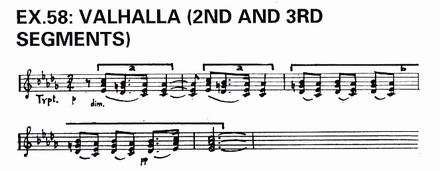
The final segment of the Valhalla motive, which is a kind of summing up of its noble character, doesn't enter until the end of the Wotan's actual apostrophe to Valhalla itself. It appears on the trumpet at the words "Noble Splendid Fortress".
《ヴァルハラ》のモティーフの最後のセグメントは、このモティーフの高貴な性格をまとめたもので、ヴォータンがヴァルハラそのものへの呼びかけを終えたときに導入されます。これはトランペットに現れ、せりふは「気高く輝く砦」です。
| EX.59: 《ヴァルハラ》 最終セグメント |

We can hear this final segment of the Valhalla motive more clearly by having the passage played by the orchestra alone.
このパッセージをオーケストラだけで演奏することで、《ヴァルハラ》の最終セグメントをよりはっきりと聴くことができます。
| EX.60: 《ヴァルハラ》 最終セグメント |

This final segment of the Valhalla motive also occurs frequently on its own. It has a habit of attaching itself to the ends of other motive as a cadence. For example, when Wotan conceives the idea of the Sword in Scene 4 of Rheingold, it rounds off the trumpet's Sword motive with the effect of setting a seal of majesty on the new conception.
この《ヴァルハラ》のモティーフの最終セグメントは、それ自体でしばしば現れます。そして、他のモティーフの終わりに付加されて終止形を作る性質があります。たとえば『ラインの黄金』の第4場においてヴォータンが "剣" のアイデアを抱くとき、このモティーフはトランペットの《剣》のモティーフを整え、その新しい考えに威厳を与える効果を発揮します。
| EX.61: 《剣》 と《ヴァルハラ》の最終セグメント |
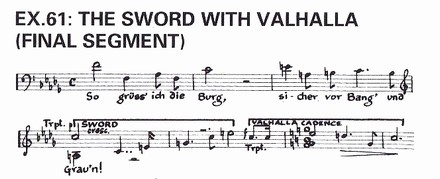
Although the complete Valhalla motive and its various segments recur throughout the whole work, the motive does not generate a family of motives. This is because Wotan's catsle is only a static symbol of his power, not a dynamic symbol of the agency of his power, akin to Alberich's Ring.
The agency of Wotan's power is his Spear. This is the other central power symbol of the drama and it has its own basic motive which does generate a whole family of motives.
こういった《ヴァルハラ》のモティーフ全体とそのさまざまなセグメントは『指環』を通して再現しますが、モティーフのファミリーを作ることはありません。その理由は、ヴォータンの城がアルベリヒの "指環" のような "力の動的なシンボル" ではなく、"力の静的なシンボル" に過ぎないからです。
ヴォータンの力を代表するのは彼の "槍" です。これはドラマのもう一つの力の中心的なシンボルであり、基本モティーフを持ち、そこからモティーフのファミリーが生み出されます。
ヴォータンの力を代表するのは彼の "槍" です。これはドラマのもう一つの力の中心的なシンボルであり、基本モティーフを持ち、そこからモティーフのファミリーが生み出されます。
CD1-Track11
The basic motive associated with the Spear has always been labelled the Treaty or Bargain motive, because Wotan's power resides in the treaties sworn on the Spear and engraved on it. But these treaties which are actually the laws whereby Wotan governs the world, are really maintained by his will. And this is what the power of the Spear represents. Wotan's Spear is the symbol of his will towards controlled, lawful world domination, just as Alberich's Ring is the symbol of his will towards uncontrolled, unlawful world domination.
And so the basic power motive associated with the Spear should take the name of the symbol itself, just as the basic power motive associated with the Ring is called the Ring motive. The Spear motive which is a stern descending minor scale, first appears in Scene 2 of Rheingold. It enters quietly on the bass when Fricka reminds Wotan that he will have to fulfil his contract with the Giants and give them the promised payment for building Valhalla, the Goddess Freia.
"槍" に関連づけられた基本モティーフは、従来から《契約》とか《取引》のモティーフと呼ばれてきました。というのもヴォータンの力の源泉は、ヴォータンが "槍" に誓い、"槍" に刻み込んだ契約にあるからです。この契約はヴォータンが世界を支配するための "掟" ですが、実際はヴォータンの意志によって支えられています。"槍" の力が表現しているのは、その意志です。ヴォータンの "槍" は秩序のある統制された世界に君臨する意志の象徴です。それはアルベリヒの "指環" が無秩序で統制のない世界に君臨する意志を象徴しているのと同様です。
従って "槍" に関連づけられた力の基本モティーフにはシンボルの名前そのものを採用すべきです。ちょうど "指環" に関連づけられた力の基本モティーフが《指環》のモティーフと呼ばれるようにです。《槍》のモティーフは厳粛に下降する短調の音階で、最初に『ラインの黄金』の第2場で現れます。フリッカはヴォータンに、巨人たちと交わした契約を履行してヴァルハラを建てる報酬の約束、つまり女神・フライアを差し出すべきことを思い起こさせますが、そのときモティーフが低音部に静かに入ってきます。
従って "槍" に関連づけられた力の基本モティーフにはシンボルの名前そのものを採用すべきです。ちょうど "指環" に関連づけられた力の基本モティーフが《指環》のモティーフと呼ばれるようにです。《槍》のモティーフは厳粛に下降する短調の音階で、最初に『ラインの黄金』の第2場で現れます。フリッカはヴォータンに、巨人たちと交わした契約を履行してヴァルハラを建てる報酬の約束、つまり女神・フライアを差し出すべきことを思い起こさせますが、そのときモティーフが低音部に静かに入ってきます。
| EX.62: 《槍》 第1形 |
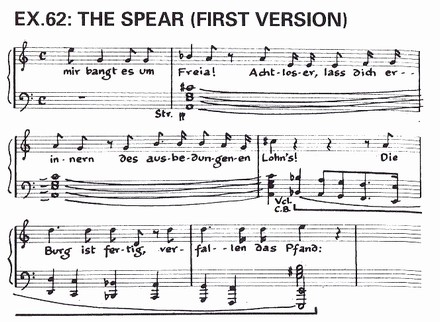
Later in the same Scene when Donner lifts his hammer to crush the Giants, Wotan stretches out his Spear and imposes the law by the main force of his will. And here the definitive form of the Spear motive beginning on a strong beat enters powerfully on the trombones.
そのあと同じ第2場でドンナーが巨人たちを粉砕しようとハンマーを振り上げるとき、ヴォータンは槍を振るって意志の力で "掟" を強制します。ここが《槍》のモティーフの確定形で、強いビートで始まり、トロンボーンで力強く演奏されます。
| EX.63: 《槍》 確定形 |
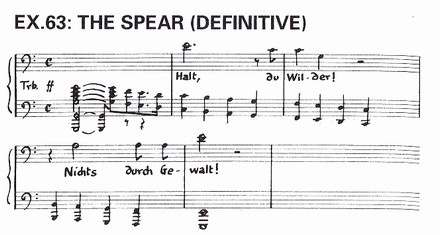
Before considering the family of motives generated by this main Spear motive, we should notice that it has another segment, concerned specifically with the irrevocable character of the treaties sworn on the Spear. This is introduced vocally by Fasolt when he warns Wotan that he must keep faith.
この《槍》から作られるモティーフのファミリーを考察する前に、このモティーフが別のセグメントを持っていることに注意すべきでしょう。それは "槍" にかけて誓われた契約は取り消しできない性質であることに関連します。これはファゾルトの歌唱で導入されます。彼がヴォータンに信義を守れと警告する場面です(訳注:第2場。EX63 の前)。
| EX.64: 《取り消しできない掟》 |

The first new motive generated by the descending scale of the main Spear motive, is a subsidiary one which represents Wotan's actual contract with the Giants. This is the real Treaty motive. Fasolt introduces it vocally, echoed by the cellos and basses, when he warns Wotan to fulfil the contract.
《槍》の下降音階から最初に作り出される新たなモティーフは、ヴォータンが巨人たちと交わした契約を表す副次的なモティーフです。これが本当の《契約》のモティーフです。ファゾルトがヴォータンに契約を履行するように警告するときに歌唱で導入され、チェロとコントラバスがそれに続きます(訳注:第2場。EX64 の直後)。
| EX.65: 《契約》 |
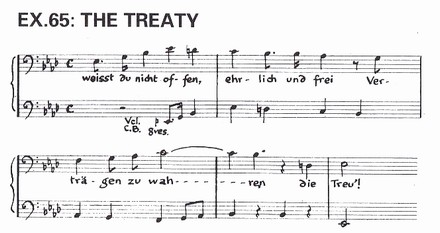
A more important transformation of the Spear motive follows immediately. This is the embryonic form of the majestic motive of the Power of the Gods which should perhaps be called the power of Wotan. When Fasolt goes on to warn Wotan that his whole power resides in the laws engraved on the Spear, the Spear motive enters in the bass, bellow a series of pulsating chords. This is the embryonic form of the motive of the Power of the Gods.
もっと重要な《槍》のモティーフの変形がすぐに続きます。これは威厳のある《神々の力》のモティーフの萌芽形で「ヴォータンの力」と呼んでもいいものです。ファゾルトがヴォータンに、彼の全ての力は槍に刻まれた契約にあるのだと警告するとき、鼓動する和音の下の低音部に《槍》のモティーフが入ってきます。ここが《神々の力》のモティーフの萌芽形です。
| EX.66: 《神々の力》 萌芽形 |
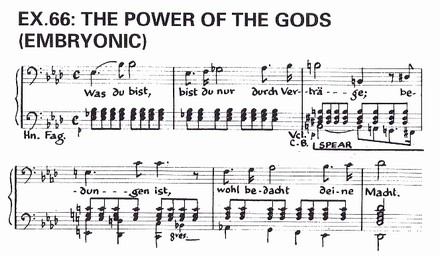
An intermediate form of this motive enters on the orchestra in Act 1 of Siegfried when Wotan tells Mime how he rules the world with the Spear which he cut from the World Ash Tree. This time, underneath the pulsating chords, the descending scale of the Spear motive alternates with its inversion, a rising scale.
『ジークフリート』の第1幕で、このモティーフの中間形がオーケストラに現れます。ヴォータンがミーメに、世界のトネリコの樹から切り出した槍でどのように世界を支配するかを説明するシーンです(訳注:第2場)。今度は鼓動する和音の下で、《槍》の下降音階がその反転形の上昇音階に変化します。
| EX.67: 《神々の力》 中間形 |
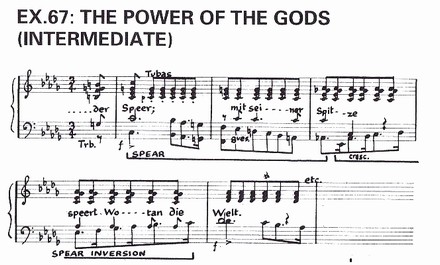
In Gotterdammerung, the rising scale detaches itself from the descending one to become the definitive form of the motive of the Power of the Gods. This enters during the Norns' scene in the Prelude, but it rises to its full strength in the Final Scene of the work, when Brunnhilde orders the funeral pyre to be built for Siegfried which will finally bring the Power of the Gods to an end.
『神々の黄昏』において、この上昇音階は下降音階から切り離され《神々の力》の確定形になります。これは序幕のノルンのシーンで現れますが、その威力がフルに発揮されるのは作品の最後のシーンです。そこではブリュンヒルデがジークフリートの葬儀の薪を積み上げるように命じ、それが最終的に神々の力の終焉をもたらします。
| EX.68: 《神々の力》 確定形 |

CD1-Track12
Along another more complex line of transformation, the Spear motive continually generates new motives throughout Walkure. These are derived from the opening 6 notes segment of the Spear motive. They are those of the Storm and of Siegmund, Wotan's son, unwitting agent, who at the beginning of Walkure is running through the storm for his life.
In each of these motives, the descending scale motion of the complete Spear motive is checked and opposed. After the first descending 6 notes segment, a rising motion contradicts it. Indeed, throughout Walkure, the repressive authority of Wotan's will is to be continually challenged by the other characters and eventually neutralized. Here, first of all, is another special illustration presenting the first descending 6 notes segment of the Spear motive.
《槍》のモティーフは、別のもっと複雑な変形の過程をだどって『ワルキューレ』の全体で新たなモティーフを継続的に生み出します。これらは《槍》の最初の6つの音のセグメントから派生したもので、《嵐》と《ジークムント》のモティーフです。ジークムントはヴォータンの息子で、ヴォータンの無意識の使者であり、『ワルキューレ』の冒頭では命を守るために嵐の中を逃げてきます。
そしてそれぞれのモティーフにおいて、完全な《槍》のモティーフの下降音階の動きは抑制され、妨げられます。最初の下降する6音のあとは、対照的な上昇する動きになるのです。実際『ワルキューレ』を通して、ヴォータンの意志が示す抑圧的な権威は他の登場人物からの挑戦を受けて次第に無力化します。ではまず最初に、特別の例示で《槍》のモティーフの冒頭の下降する6音を聴いてみましょう。
そしてそれぞれのモティーフにおいて、完全な《槍》のモティーフの下降音階の動きは抑制され、妨げられます。最初の下降する6音のあとは、対照的な上昇する動きになるのです。実際『ワルキューレ』を通して、ヴォータンの意志が示す抑圧的な権威は他の登場人物からの挑戦を受けて次第に無力化します。ではまず最初に、特別の例示で《槍》のモティーフの冒頭の下降する6音を聴いてみましょう。
| EX.69: 《槍》 第1セグメント |

Now here's the Storm motive. It consists of the first descending 6 notes segment of the Spear motive, played swiftly in alternation with its inversion, the same notes rising upwards.
さて《嵐》のモティーフです(訳注:『ワルキューレ』前奏曲の冒頭)。これは《槍》の最初の下降する6音のセグメントと、それに素早く替わって演奏される反転形、つまり同じ音の上昇形からできています。
| EX.70: 《嵐》 |

Out of the Storm motive emerges very similar motive of Siegmund who is to rebel against Wotan's authority. This also enters in the bass, and again, the first descending segment of Spear motive is checked and contradicted by a rising motion.
《嵐》のモティーフから、非常に似た《ジークムント》のモティーフが出てきます。ジークムントはヴォータンの権威に反逆しようとしています。このモティーフもまた低音部に導入され、《槍》のモティーフの最初の下降するセグメントは再び抑止されて上昇する動きが対比されます。
| EX.71は『ワルキューレ』前奏曲の終わりのあたりで、《嵐》が《ジークムント》のモティーフに変化するところ。 |
| EX.71: 《ジークムント》 |

A little later in Act 1 of Walkure, Siegmund's falling and rising motive is joined by the rising and falling one of Sieglinde. As the mood grows more tender, the upward motion, contradicting the Spear motive's descent, grows stronger.
『ワルキューレ』第1幕の少し後で《ジークムント》の下降して上昇するモティーフは、《ジークリンデ》の上昇し下降するモティーフと結びつきます。そして雰囲気が次第に優しくなるにつれ、《槍》のモティーフの下降音とは対照的な上昇する動きが強くなってきます。
| EX.72は『ワルキューレ』第1幕の冒頭、ジークリンデの最初の歌唱。 |
| EX.72: 《ジークムントとジークリンデ》 |

CD1-Track13
In Act 2 of Walkure, Wotan's authority is effectively thwarted by Fricka who argues him into abandoning Siegmund and the plan of which Siegmund is the unwitting agent. The gloomy motive associated with Wotan here is generally known as Discouragement. But it might be called the "frustration of Wotan's will", since it's a twisted form of the first descending 6 note segment of the Spear motive. Here's the segment again as a reminder.
『ワルキューレ』の第2幕においてヴォータンはフリッカに論駁され、その権威は失墜します。その結果ジークムントを見捨てることになり、ジークムントを無意識の使者にする計画もなくなります(訳注:第2幕 第1場)。このシーンでのヴォータンに関連づけられた陰気なモティーフは、一般的には《不機嫌》として知られています。しかしそれは "ヴォータンの意図の挫折" と呼べるでしょう。なぜなら、このモティーフは《槍》のモティーフの最初の6つの下降音の捻れた形だからです。リマインドのため《槍》の最初のセグメントを聴いてみましょう。
| 《槍》 第1セグメント: EX.69 |

This segment, freely transformed, generates the motive of Wotan's Frustration. The motive begins with a little turn twisting moodily around the first note. And not only is the descending motion opposed by a rising one, but it's also hindered by being turned around on itself.
このセグメントは自由に変形され《ヴォータンの挫折感》のモティーフを生み出します。そのモティーフは、最初の音の周りに陰気に捩れるターン(=回音)で始まります。そして《槍》の下降音が対照的な上昇音に妨げられるだけでなく、それ自体も揺れ動きます。
| frustration は「苛立ち」とも訳せるが、一つ前の説明でデリック・クックは "frustration of Wotan's will" と言っているので「挫折」が適当。またモティーフの名称としては "心理的側面を重視する" という観点から「挫折感」とした。 |
| EX.73: 《ヴォータンの挫折感》 |

Incidentally this motive, like several others, takes on a new form in Gotterdammerung. The tragic happenings in that work are felt to be at least partly the result of Wotan's change of mind after his humiliation by Siegfried. His sense of frustration which disappears in the opera Siegfried returns in Gotterdammerung, and grows more acute as we learn from Waltraute. And this is expressed by a new leaping and falling form of the motive of his Frustration. We hear it in the orchestra after the Waltraute has told Brunhilde of Wotan's indifference to everything except the idea of restoring the Gold to Rhinemaidens.
さらに言うとこのモティーフは、他の数個のモティーフと同じように『神々の黄昏』で新たな形をとります。この楽劇の悲劇的な出来事の少なくとも一つの原因は、ジークフリートから受けた屈辱によってヴォータンが心変わりしたことだと感じられます。楽劇『ジークフリート』では消えていたヴォータンの挫折感は『神々の黄昏』で戻ってきて、より鮮明になっていることがヴァルトラウテの言葉からわかります。この挫折感は、跳躍して落ちる新しいモティーフで表現され、ヴァルトラウテがブリュンヒルデにヴォータンの無関心について語る時のオーケストラに聴くことができます。ヴォータンは黄金をラインの乙女に返すこと以外には関心が無くなっているのです。
| EX.74 は『神々の黄昏』第1幕 第3場のヴァルトラウテの歌唱のところ。 |
| EX.74: 《ヴォータンの挫折感》 第2形 |

This motive recurs many times in Gotterdammerung, especially in conjunction with Hagen's plotting to destroy Siegfried, since this act will set in motion the series of events that is to lead to the restoration of the Gold to the Rhinemaidens.
このモティーフは『神々の黄昏』でたびたび再現し、特にジークフリートを殺害しようとするハーゲンの陰謀に関して現れます。というのも、黄金をラインの乙女に戻すことになる一連の出来事が、この陰謀に起因しているからです。
| EX.75 は『神々の黄昏』第2幕 第5場のハーゲンの歌唱のところで、ハーゲンがジークフリートの殺害に言及してグンターが驚く場面。 |
| EX.75: 《ヴォータンの挫折感》 ハーゲン形 |
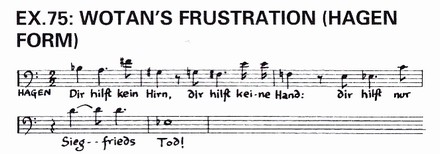
CD1-Track14
Returning now to Act 2 of Walkure, after Fricka's exit, Wotan rages against her thwarting of his will, and here, the motive of his Frustration is inverted moving upwards instead of downwards. Moreover, it moves straight upwards without convolutions. And in doing so, it generates the furious motive of Wotan's Revolt which is thus a free inversion of the whole original Spear motive. It always merges into the motive of Curse as here on its first appearance.
『ワルキューレ』の第2幕に戻りましょう。フリッカが退場したあと、ヴォータンは彼女に意図を砕かれたことに怒り狂います。ここで《挫折感》のモティーフは下降から上昇へと反転します。しかも回音はなしでストレートに上昇し、その結果《ヴォータンの反抗》という怒りのモティーフを生み出します(訳注:第2幕 第2場)。これは元々の《槍》のモティーフを自由に反転させたものです。このモティーフは常に《呪い》のモティーフと融合しますが、その最初の現れがここです。
| EX.76: 《ヴォータンの反抗》 |
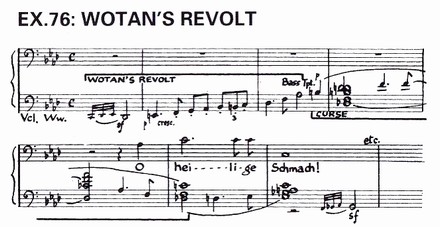
In Act 3 of Walkure, the twisted motive of Wotan's Frustration evolves gradually into the motive associated with Brunnhilde's rebellion against him, the motive of the Reproach she addresses to him. At the beginning of this scene, we hear the transformation take place. The motive of Wotan's Frustration on the bass strings is answered by a free transformation of it on the bass clarinet in which the descending motion of the original Spear motive is now opposed by a wide leap to the upper octave.
『ワルキューレ』の第3幕において《ヴォータンの挫折感》の "捻れた" モティーフは、次第にブリュンヒルデのヴォータンに対する反抗に関連するモティーフへと進化します。それはブリュンヒルデのヴォータンに対する《非難》のモティーフです。このシーンの出だしのところで変形が起こっていることが聴き取れます。低音弦の《ヴォータンの挫折感》のモティーフは、自由に変形されてバス・クラリネットにも現れ、そこでは元々の《槍》の下降する動きが1オクターブ上への大きな跳躍と対比されます。
| 《ブリュンヒルデの非難》は、《ブリュンヒルデの哀願》とか《訴え》とも呼ばれるが、デリック・クックが使っている reproach という言葉に「哀願」や「訴え」のニュアンスはない。EX.77, EX.78, EX.79 は第3幕 第3場。 |
| EX.77: 《ヴォータンの挫折感》 / 《ブリュンヒルデの非難》 |
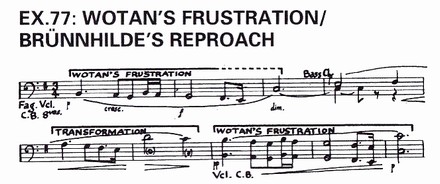
This bass clarinet phrase is taken up by Brunnhilde as she reroaches Wotan for condemning her disobedience, her attempt to carry out his original plan which she knew he had countermanded in spite of his deepest wishes. Her Reproach motive presents the full descending scale of the Spear motive continually opposed by leaps to the upper octave.
このバス・クラリネットのフレーズは、彼女の不従順を責めるヴォータンを非難するブリュンヒルデに移ります。彼女はヴォータンの元々の計画を遂行するよう試みましたが、ヴォータンは強い希望とは裏腹に計画を撤回したことを彼女は知っているのです。彼女の《非難》のモティーフでは《槍》の下降音階と、それに対比されるオクターブ上への跳躍が連続します。
| EX.78: 《ブリュンヒルデの非難》 |
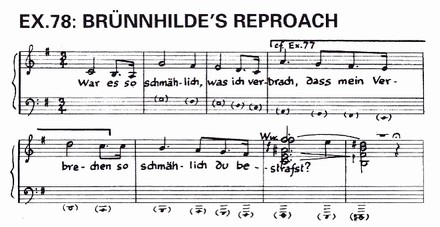
Later on, in this Act, this motive of Brunnhilde's Reproach turns to the major to become a new motive representing the positive symbol she is opposing to the authority of Wotan's Spear, Compassionate Love. The motive enters on the orchestra as Brunnhilde tells Wotan what has made her defy his orders was the feeling of love which he himself had breathed into her and which had been awakened by her realization of Siegmund's love for Sieglinde.
この幕の後の方で《ブリュンヒルデの非難》のモティーフは長調に転換し、新たなモティーフになります。それはヴォータンの "槍" の権威に対抗する彼女のポジティブなシンボルとなる《哀れみの愛》です。このモティーフがオーケストラに入ってくるときブリュンヒルデはヴォータンに、命令に逆らったのは愛の感情だったと語ります。その愛の感情はヴォータン自身がブリュンヒルデに吹き込んだものであり、ジークムントのジークリンデに対する愛を彼女が認識したことで呼び覚まされたのでした。
| EX.79: 《ブリュンヒルデの哀れみの愛》 |
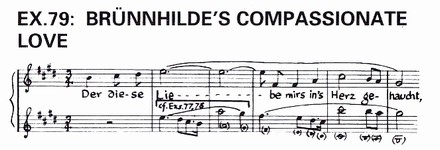
So the repressive descending minor scale of the Spear motive is finally transformed into the expansive soaring motive associated with Brunnhilde's Compassionate Love. And this is the last of the family of motive generated by the basic motives of the Spear.
このようにして、短調の抑圧的な下降音階である《槍》のモティーフは、最終的に《ブリュンヒルデの哀れみの愛》を表す、広がって高く舞い上がるようなモティーフに変形しました。これが基本モティーフ《槍》から作り出されたファミリーの最後です。
ライトモティーフ譜例一覧(2)
|
| 指環 |
| 《 | 指環》萌芽形 | |||
| 《 | 指環》中間形 | |||
| 《 | 指環》確定形 | |||
| 《 | 指環》基本和声 | |||
| 《 | 指環》骨格 | |||
| 《 | 思案》 | |||
| 《 | 指環》減3和音 | |||
| 《 | 怨念》 | |||
| 《 | 指環の力》ハーゲン形 | |||
| 《 | 殺害》 | |||
| 《 | 指環》最初の4音符 | |||
| 《 | 呪い》 | |||
| 《 | フンディングの正義》 | |||
| 《 | 贖罪の誓い》 | |||
| 《 | 財宝》 | |||
| 《 | 大蛇》 | |||
| 《 | 大蛇としてのファフナー》 | |||
| 《 | 指環》ヴァルハラへ変化 | |||
| 《 | ヴァルハラ》第1セグメント | |||
| 《 | ヴァルハラ》第2・第3セグメント | |||
| 《 | ヴァルハラ》最終セグメント | |||
| 《 | ヴァルハラ》最終セグメント | |||
| 《 | 剣》と《ヴァルハラ》の最終セグメント |
| 槍 |
| 《 | 槍》第1形 | |||
| 《 | 槍》確定形 | |||
| 《 | 取り消しできない掟》 | |||
| 《 | 契約》 | |||
| 《 | 神々の力》萌芽形 | |||
| 《 | 神々の力》中間形 | |||
| 《 | 神々の力》確定形 | |||
| 《 | 槍》第1セグメント | |||
| 《 | 嵐》 | |||
| 《 | ジークムント》 | |||
| 《 | ジークムントとジークリンデ》 | |||
| 《 | ヴォータンの挫折感》 | |||
| 《 | ヴォータンの挫折感》第2形 | |||
| 《 | ヴォータンの挫折感》ハーゲン形 | |||
| 《 | ヴォータンの反抗》 | |||
| 《 | ヴォータンの挫折感》/《ブリュンヒルデの非難》 | |||
| 《 | ブリュンヒルデの非難》 | |||
| 《 | ブリュンヒルデの哀れみの愛》 |
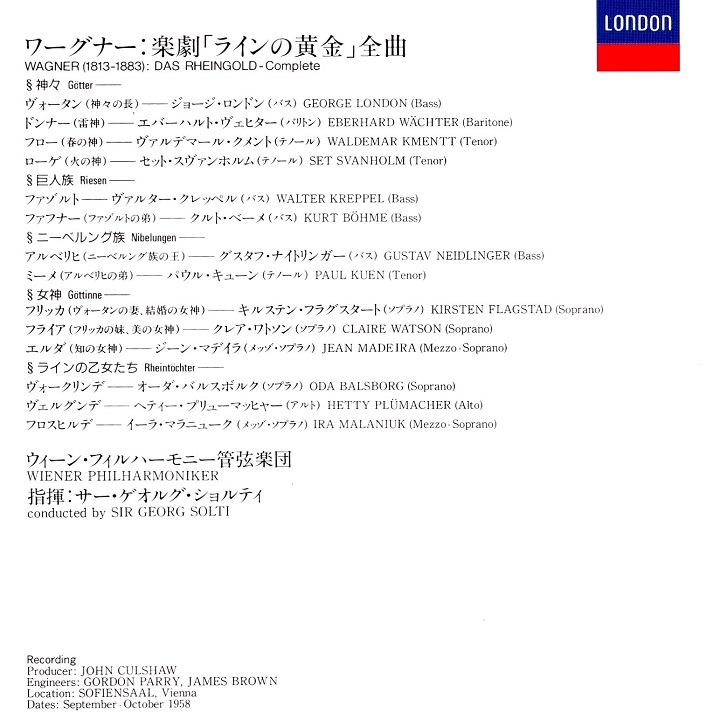
|
2019-05-10 16:13
nice!(2)



